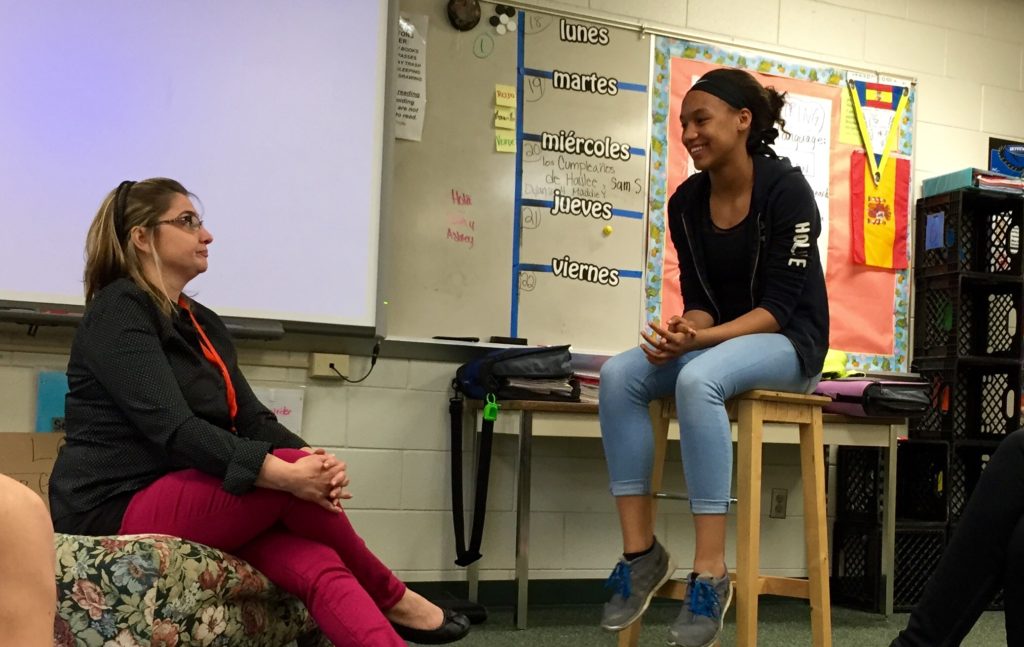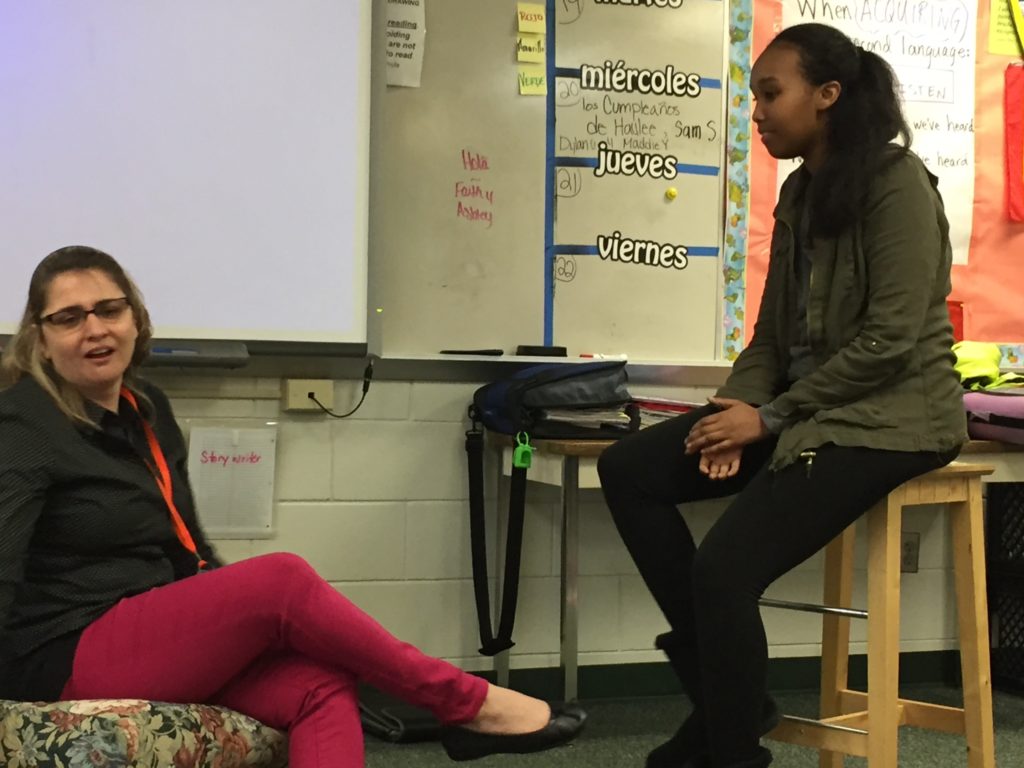Our brains were built to make sense of other brains and to understand everyone’s place in the pecking order.
–Matthew Lieberman, Social
Personal interviews have become a major component of how we build a positive learning community and develop meaningful proficiency in Spanish 1. In the fall, I interview students and invite them to share information about themselves. These interviews with complete novice learners are, initially, not terribly exciting. As a result, they’re short in duration – perhaps 7-10 minutes. Over the course of the year, they grow in duration and detail. They also change in how much of the interview is teacher driven and how much is student driven. Over time, I allow students to ask follow-up questions of their peers and sometimes even attempt to lead an interview.
Over the last several years the number of visitors coming to observe class has increased. One student job is to greet visitors and introduce them to the class. After the class says hello and welcomes the visitor in unison, I typically open up the floor for student questions directed to the visitors. In the last couple of months January through March, most of the questions have been the same questions that I have asked them:
- Where do you live?
- Where are you from?
- Do you have any pets?
- Do you have any special talents?
- Do you have a family?
Students have asked these questions from their seats while the class interpreter (another student job) interprets from Spanish into English and the standing visitor responds. The information provided by the visitor has sometimes shown up on end of class period quizzes giving students a purpose to listen.
But this week, I felt a tremor in the force. With all day visitors on Wednesday and Thursday, we spent almost the entire class on both days interacting with the visitors. Having recently listened to Bill VanPatten talk about the importance of having a purpose, I clearly stated ahead of time that at the end of the class, students would be held responsible for recalling and producing 7 to 10 facts about our visitors.
Another change I made spontaneously on Wednesday was that I did not allow a new, topic-changing question immediately. Rather, I stated quickly in English that the answer to the question allowed for a clear and obvious follow-up question that somebody in the class needed to ask. For example, the visitor said she had a child. One clear and obvious follow-up question was what’s the name of the child. Next, another student asked how old the child was. Another student asked what the child likes to do. In this way, my students were not just practicing Spanish questions, but they were demonstrating interest and inviting a new person in to our community.
The next day I changed things up just a bit to keep the process of interviewing a guest from becoming mundane. My students of course are getting better at asking the typical questions. That’s why I had probed for deeper questioning on Wednesday. On Thursday I added another element. Instead of having students raise their hand and asked question, I invited our guest to sit in the front of the room on an ottoman that I have in the classroom. It’s a special chair reserved for special times. I took my teacher stool and I set it next to her and I modeled for the students. I said in the target language, “Class, if you would like to ask our guest a question, please come up to the chair, cross your legs, look her in the eyes and ask your question. After she responds, turn to the class and report out her response.”

This simple change was empowering beyond my expectations. Several students jumped at the chance to come up to the chair. But I was struck most by one female student in particular. She came up to the chair no fewer than three times to ask questions and report out to the class. Despite not having volunteered any language between September and March beyond choral responses and the occasional one word response to a targeted question, her tone was confident, her language was accurate and her accent was beautiful. And her smile was radiant. This shy individual had rarely even spoken in class until this time. Needless to say, we all applauded loudly each time. I even saw genuinely proud smiles on several students’ faces. 8th graders? Demonstrably proud of their classmates? That made me one of the proudest people in the world in that moment.
 The interviews lasted nearly the entire class period with several students volunteering questions and many, many laughs all day long. Several students combined and recombined the questions that we typically ask in order to create novel questions I had never asked and they had never heard. More than one student asked two part questions. Here are some examples of the questions asked:
The interviews lasted nearly the entire class period with several students volunteering questions and many, many laughs all day long. Several students combined and recombined the questions that we typically ask in order to create novel questions I had never asked and they had never heard. More than one student asked two part questions. Here are some examples of the questions asked:
- ¿Cuál es tu primera lengua? What is your first language?
- ¿Tienes un equipo de fútbol favorito? Do you have a favorite soccer team?
- ¿Por qué te gusta Messi más que Neymar si Messi no es de Brasil? Why do you like Messi more than Neymar if Messi is not from Brazil?
- ¿Cuál es tu palabra favorita en español y qué significa en inglés? What’s your favorite word in Spanish and what does it mean in English
- Si tú hablas inglés y portugués en la casa, ¿cuál lengua prefiere tu hijo? If you speak both English and Portuguese at home, what language does your son prefer?
Toward the end of each class, we recycled and reviewed the information we had gathered. I had students voluntarily retell details. I wrote these sentences on our board. Then, students volleyball read it with a partner and wrote it into their class notebooks. But watching the teacher write stuff on the board can get boring. Along the way, I made sure to keep the interest and engagement of my students. Here are a couple ways I did that:
- I stopped writing and asked students to spell the next word.
- I intentionally misspelled a word or wrote an incorrect detail, prompting a loud, “¡No es correcto!” from the class.
- I did “De tín marín” (“Eenie meenie miney mo” in Spanish) to select an involuntary volunteer to give a detail that I was sure all students knew.
- I picked strong students to write one of the sentences.
- I compared and contrasted the information from our guest with information about our classmates that we already knew.
- I picked not-so strong students to spell the next word on the board (someone I knew could spell a word, but doubted could spell all words of a sentence accurately without support).
- I whispered a few questions, sang a couple and shouted one or two as well.
- I did a pop-up grammar lesson about why we put an “a” in front of the person’s name in the structure, “A Tim le gusta“.
After Wednesday’s classes, my visitor reported having felt welcomed into our community. She felt special because the students cared enough to ask questions about her life. On Thursday our visitor reported the same. She had recently student taught in a level 2 class. She shared that my Skyview students communicated with greater fluency. But what struck her most was that nearly all students were engaged, smiling and volunteering to speak the target language in each of my five classes.
Having visitors to class can be stressful. But, it provides my students and me an excellent opportunity for authentic expression and interpretation of meaning for the genuine purpose of getting to know someone and welcoming them into our community.
This is just magnificent! Sharing the blog. So worth learning from.
I am so intrigued by the special person interview and see that it can teach so many social skills. Can you clarify one thing? When the student interviewer is questioning do you have an interpreter translate each question if the visitor does not speak the target language? Just checking. Thanks!
Hi Anne,
Yes! If the guest doesn’t speak the TL, I have a student interpreter job to make sure the guest understands. This person can also sit next to an observing guest during class to answer any questions the guest has about what is being said. Thanks for reading and commenting!!
Impressive.
How did your students learn to ask these questions? I hope you can share the tasks/activities that helped student acquire these.
Really like your work with rejoinders, and your write-up about circling was my first attempt at CI.
Hi Joey. It’s a process of scaffolding. At the beginning of the year I ask the questions. Over the course of the year I encourage and allow space for students to begin to ask questions. By the spring, more kids are comfortable asking the basic questions and many are off to the races, creating new and novel questions with combinations of words from prior interviews and other class activities (like stories).
I’m completely blown away that my write-up would guide you in your first go round! I hope it proved helpful! Let me know how it’s going and what questions you have!